
Earning links without a plan is a road to nowhere. I’ve compiled everything you need to know to create a solid link-building plan from scratch.
TL;DR
A link-building plan lays down the goals, strategies, and budget you should stick to on your way to creating a strong link profile and achieving your search performance objectives.
If you want to boost the authority of your website, you need a link-building plan. If you want to reach the first page of search results, you need a link-building plan. If you want to increase traffic, you need a link-building plan. If you want to drive leads from organic traffic, you need a link-building plan.
Imagine your competitors all have backlinks from the BBB, GBP, and a local Chamber of Commerce. You do not have these links. How likely is it that Google will consider your website as authoritative as/more authoritative than those competitors?
The short answer is Google won’t. Remember that Google is in the business of providing authoritative answers to a user query. Backlinks are the portion of what conveys your expertise and so should be part of your toolkit.
Have you heard of the “spray and pray” method? It involves trying a bunch of strategies at once, hoping that the result will follow. Well, it doesn’t work.
To get tangible results (preferably, within the shortest possible timeframe), you need to establish a plan envisioning your path to success. Without a plan, it’s just a shot in the dark.
Link building is as much a project as a product launch or an advertising campaign. And every project should start with a clear objective. From there, you’ll be able to define the strategies that will get you closer to your goal.
As you implement your link-building strategies, you can use your plan to track progress, analyze what works, and make informed adjustments.
Your plan will determine the success of all the efforts you put into link building. So you’d better take it seriously.

Your investment in link-building starts here. Literally. You need a reliable backlink analysis tool to do the initial research, find link-building opportunities, and monitor your results. I’ve been using Ahrefs for years (I wish it was an ad, but it’s not), and it works well. You can go for it, too, or pick any alternative solution like Semrush or Ubersuggest.
💡Tip: Your choice of software may greatly affect the costs of your project as you upscale your SEO game — so it’s best to make sure plans don’t get unreasonable as you grow.
Not sure where to start? Editorial.Link will help you plan your project and land your first high-quality links for you.
At this point, you probably have an idea of your SEO target pages. Most likely, these are high-intent ones (i.e. commercial pages).
The decision about which page to begin with ultimately hinges on your objectives (goals and strategies of your SEO campaign), as well as whether you are building from the ground up or already possess traffic and domain authority.
It can be tempting to begin with “money pages,” i.e., transactional pages where conversions are desired, such as product pages or service landing pages. This ensures that any links built are closely tied to your direct conversion goals, thus aiding your business’s growth effectively.
While it seems the most obvious choice, it’s not necessarily the right one.
It’s critical to acknowledge that “money pages” are not always the right starting point for every business. If your website is new or if your brand is still establishing its authority and trust in the online market, focusing initially on informational content can be beneficial. This contextually rich, valuable, and user-centric content can earn better link profiles and provide users with valuable answers to their queries. Building links for blogs, how-to guides, or useful resources can still increase your site’s visibility and audience reach.”
Note: In my experience with SaaS, product pages seldom rank at the top. Pages that provide context or showcase your product in action tend to yield better results.
I couldn’t agree more. It would be hard to build links for a site that doesn’t have informational content, especially in a highly competitive niche.
Take the more natural approach. I’d say go with informational to start. It makes more sense that more people would link to a ‘Best of’ or ‘How To’ article than a product page. Focus on passing some link juice through informational content, and as the commercial page begins to move up in rankings, you can start to put more focus on building links there.
Other experts advise taking a blended approach, that is supporting commercial pages with informational content and building links for both. Indeed, if you have the resources to scale up link-building in both directions, this is the fastest way to success.
Homepage branded links are a great start. Keep it holistic by creating clusters of info content that supports each commercial page. Then keep a nice pace getting links to both which naturally the info pages will get more links because there will be more of them.
And yes, it works for e-commerce, too.
In ecommerce, build links to collection pages, but also create informational content that interlinks to these ‘money pages’ and then power up the blog posts.
These recommendations are applicable when you build a site’s link profile from scratch.
If your site already has a history, you’ll need to make a decision based on its search performance. Although it may feel intuitive to start building links for pages that have been lagging behind, it’s often best to go the counterintuitive way: give a boost to the pages that have reached the first page of search results, but haven’t made it to the top 3 yet.
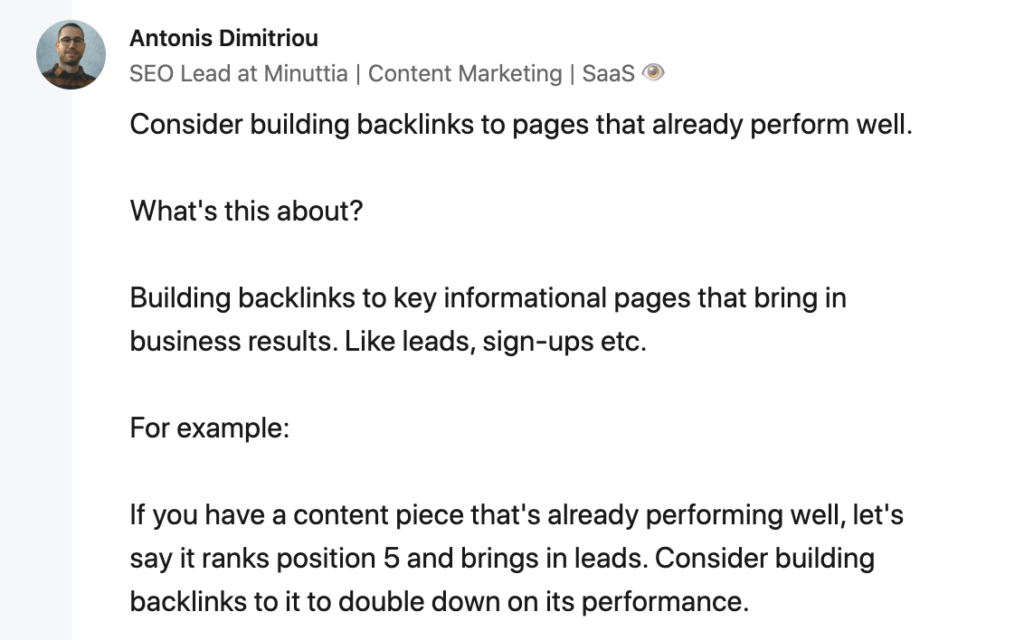
There are many more factors that will affect your choice of target pages, anchor texts, and placements. You need to deeply understand your target audience, their search intent, the competitive landscape, and other factors to build a link-building plan that works.
❗Important note: Whether you pick the right keywords for your target pages or not will determine the success (or lack of thereof) of the entire project. The most common mistake among inexperienced SEOs is failing to consider the search intent behind the queries.
Editorial.Link will save you the trouble of building a link-building plan on your own. Entrust your project to a team of link-building experts and enjoy the results.
Link building is the cherry on top of your SEO strategy, but its effectiveness relies heavily on the foundation you've laid. Before you get started with link building, ensure every aspect of your website is in the right place and optimized for success.
Begin with a technical SEO audit:
💡Tip: You can run a site audit in Ahrefs to identify site health issues within seconds.
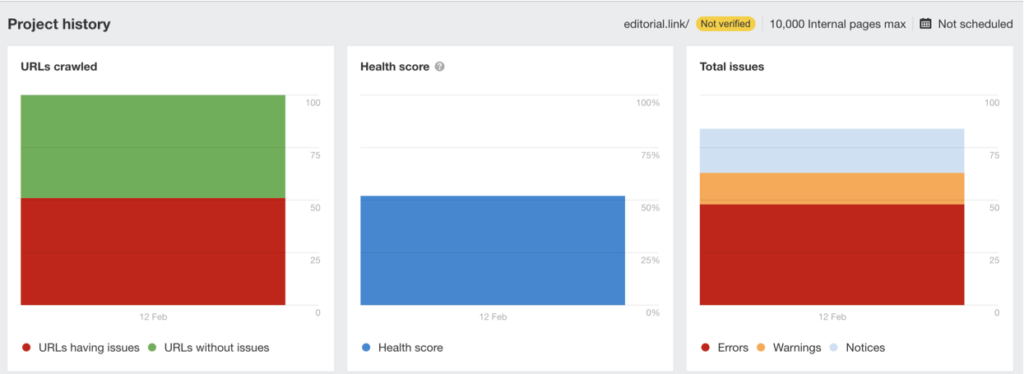
Then move on to content audit. Focus on the pages you want to build links for:
💡Tip: Run a keyword gap analysis to find the keywords your competitors rank for, and you don’t. This is how you’ll reveal plenty of opportunities you’re missing out on. You may implement these keywords into your existing content or develop new pages around these topics.
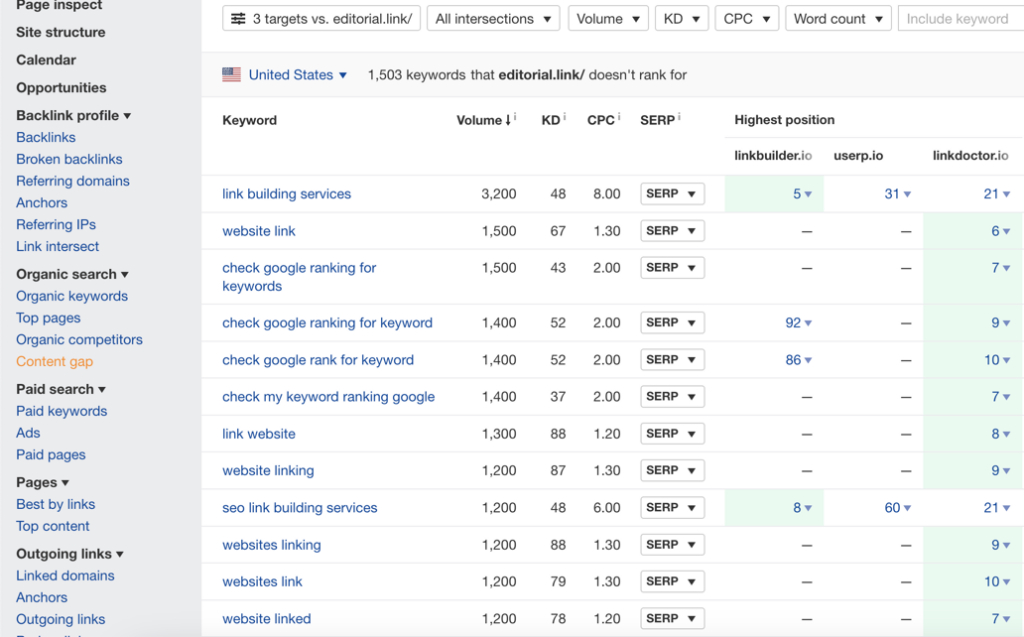
Using a tool you’ve picked earlier (Ahrefs, Semrush, Ubersuggest, or any other software), examine your competitors' backlink profiles. By doing so, you’ll get a grasp of the landscape and identify worthwhile linking opportunities.
First off, identify your search competition. The easiest way to do it is by inputting your target keywords into the SEO tool to identify sites ranking for similar terms.

💡Tip: Once you have a list of sites, manually check each to pinpoint the ones that closely align with your business in terms of topical relevance and maturity. If you haven’t earned a reputation in the industry yet, there’s no sense in comparing your strategy against established players. Prioritize sites that are more aligned with your current standing and objectives.
For instance, if you built links for a startup developing a new CRM system, you would need to focus on competitors within your category rather than comparing strategies with industry giants like HubSpot. They started content marketing and SEO many years ago, earning their reputation over time. What works for them won’t work for a startup.
You can, however, estimate the traffic potential for your niche based on your competitors’ reports.
Now, look into your competitors’ link profiles, filtering inbound backlinks by authority and traffic.

Explore the types of content that attract backlinks for your competitors and try to make assumptions about the nature of those links. While most of them can hardly be replicated, search for the low-hanging fruit — such as directory links, listicles, interviews, and guest posts.
When analyzing competitors’ link profiles, you have a chance to get a grasp of the number of links you’ll need to outperform your competition. Here’s how you can do it:
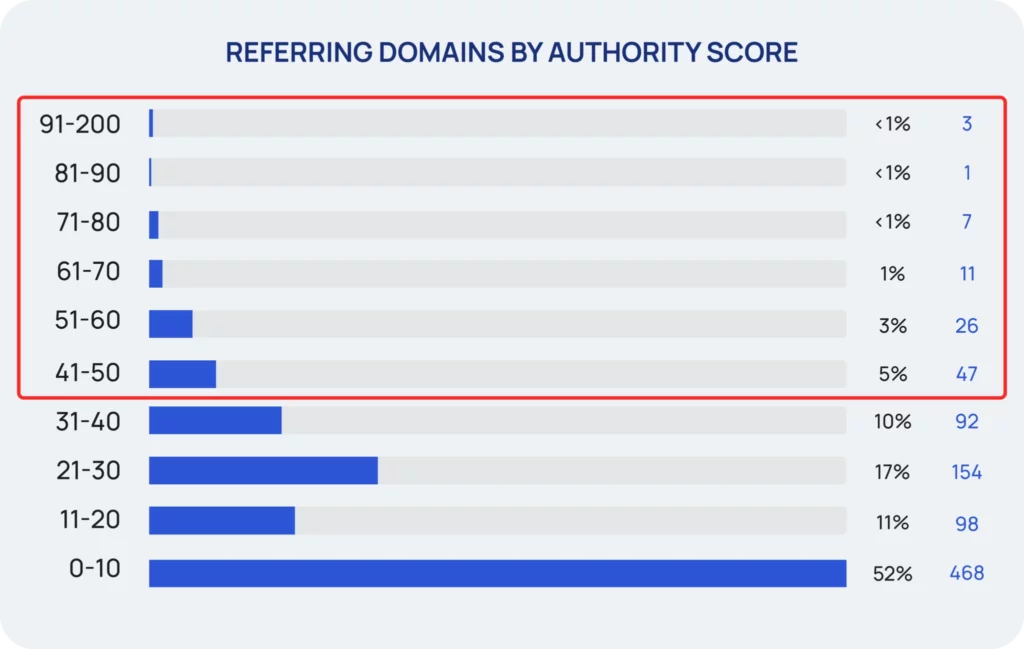
When you know your target pages, it’s easier to pick link-building techniques that align with your goals.
A mix of different tactics tailored to your goals and resources can be more beneficial than relying on a single strategy. I recommend considering these in the first place:
- Create quality content. Focus on submitting high-quality, relevant content to top-tier websites. Utilize strategic branding and non-branded keywords for backlinks to your site’s blog or landing page.
- Try PR. Engage in PR activities by contributing bylines and interviews to industry-centric publications. This not only aids in link-building but also bolsters your credibility.
- Collaborate. Partner with other businesses and contribute valuable content to their platforms. In-context backlinks from these collaborations are highly beneficial for SEO.
- Utilize LinkedIn Pulse. Publish content on LinkedIn Pulse to take advantage of its tendency to rank well on Google, providing another avenue for creating backlinks.
Guest blogging is a very resource-intensive link-building strategy, but it’s the easiest to scale (among white hat methods). You can use it to build links to informational content on your site and your partners’ sites. For instance, if you add 5–7 partner links in a guest post, you'll get 5–7 reciprocal links per post, plus one or two links pointing to your own site from the guest post.
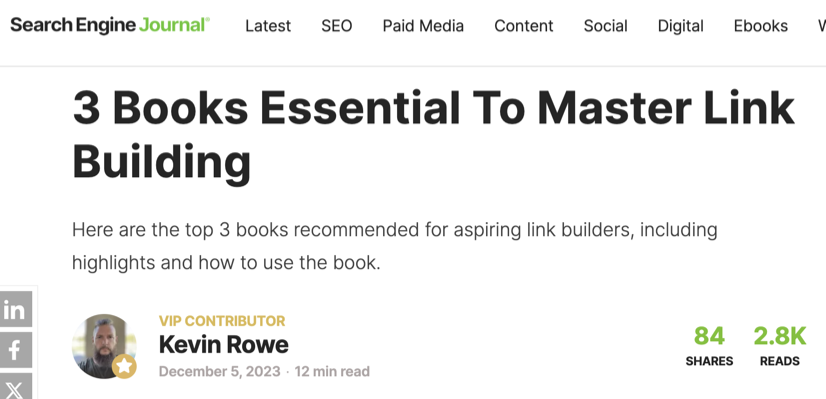
Connectively (ex-HARO) is a platform that connects journalists and subject matter experts. Content creators publish commentary requests on Connectively to get quotes from expert sources and include them in their articles. If you’re lucky enough, you may secure placements on exclusive websites for free (or almost for free).
It’s a great place to build links for your homepage.
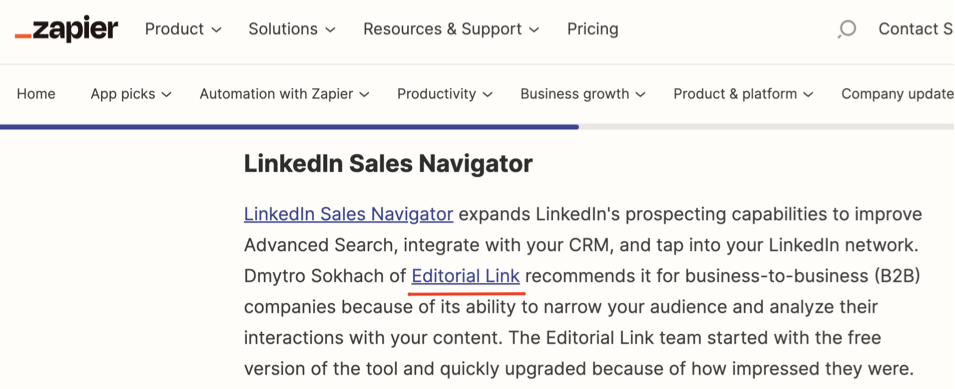
Editorial links are the most powerful type of backlinks. They point out to your website (most likely, informational pages) from a blog of a trusted site. You can acquire them naturally or… try niche edits.
Niche edits are links built from existing content rather than newly published content. To make it work, you need link-worthy content and strong communication skills.
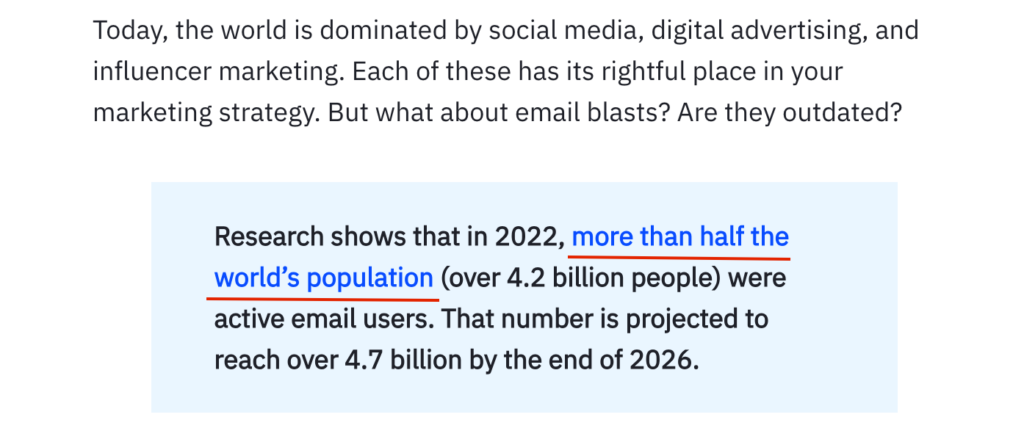
Editorial.Link can handle it for you. We’ve built thousands of editorial links from high-authority websites for our clients. Become our next success story.
Whatever link-building strategy you choose, you can level it up with linkable content.
Writing guest posts? There’s a greater chance the editor won’t remove your links if they point to quality, relevant content.
Building links through HARO? You may try to promote your research or experiment if it’s relevant to the request.
In any scenario, things are easier with link-worthy content.
How to create content that people want to link out to? Think original research, infographics, thought leadership content, and experiments. The key is to offer something that others in your field find so insightful that they can't help but link to it.
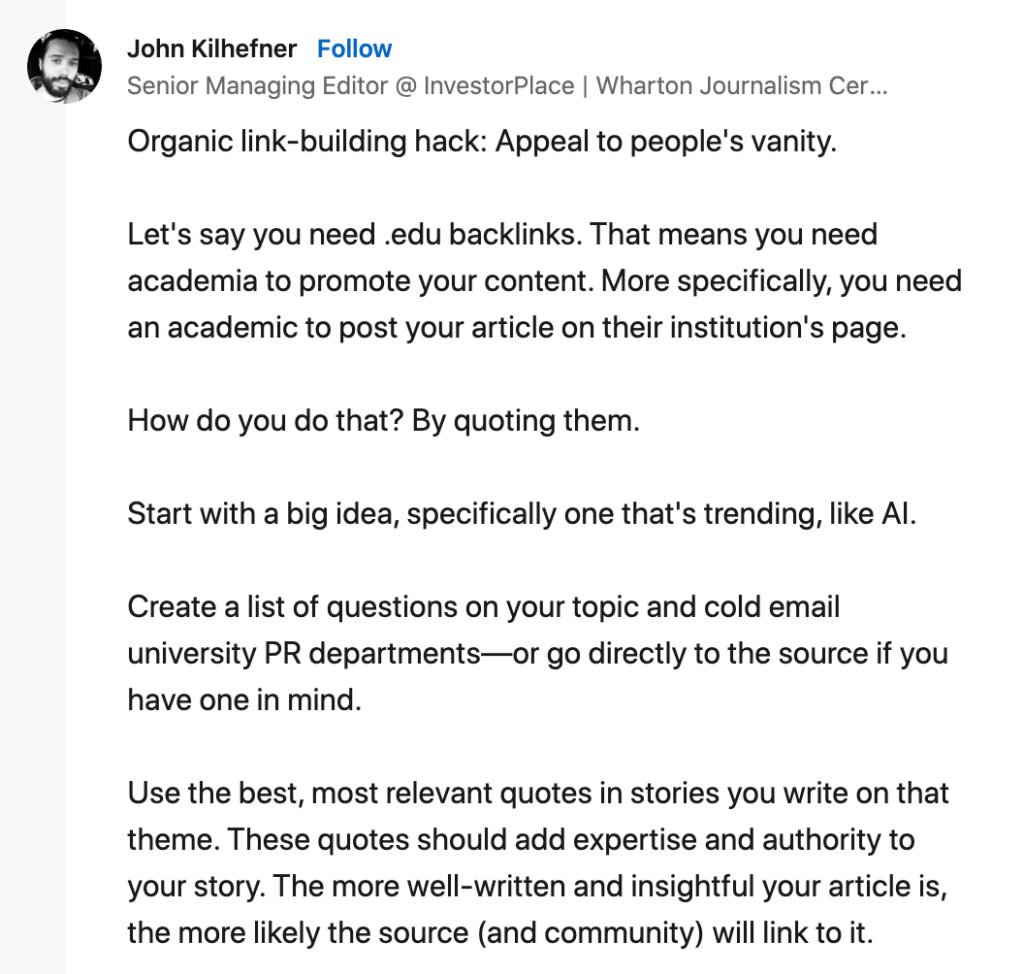
After you’ve estimated the number of links you need and chosen your strategy, you get an idea of the budget needed to translate your plan into life.
Fery Kaszoni has created a handy breakdown of link-building budgets by the level of competition in the niche and the techniques employed. By the way, this is an excellent example of link-bait content.

Generally, monthly expenses can start at around $600 in a low-competition niche if you outsource the task to a reliable freelancer. I’d like to emphasize the word “reliable” here because you can also land hundreds of links for around $50 with Fiverr freelancers, but these will be low-quality, tiered links.
If you lean toward hiring an in-house specialist, don’t forget to calculate overhead expenses before you jump at the idea. When you’re just starting out, outsourcing is often faster and more cost-efficient.
To save your budget without sacrificing the quality, consider outsourcing link-building to an established agency. The Editorial.Link team has spent years building relationships with partner sites, and you have a chance to tap into our expertise and connections and get immediate results. Contact us to get a sample of high-authority links for free.
How to make sure you’re steadily moving toward your objectives? Watch out for the following criteria to keep your finger on the pulse:
As you build up your link profile, you should be able to track the positive effect on your key SEO and business metrics such as organic traffic, leads, conversions, etc. The right metrics to monitor will depend on your goals.
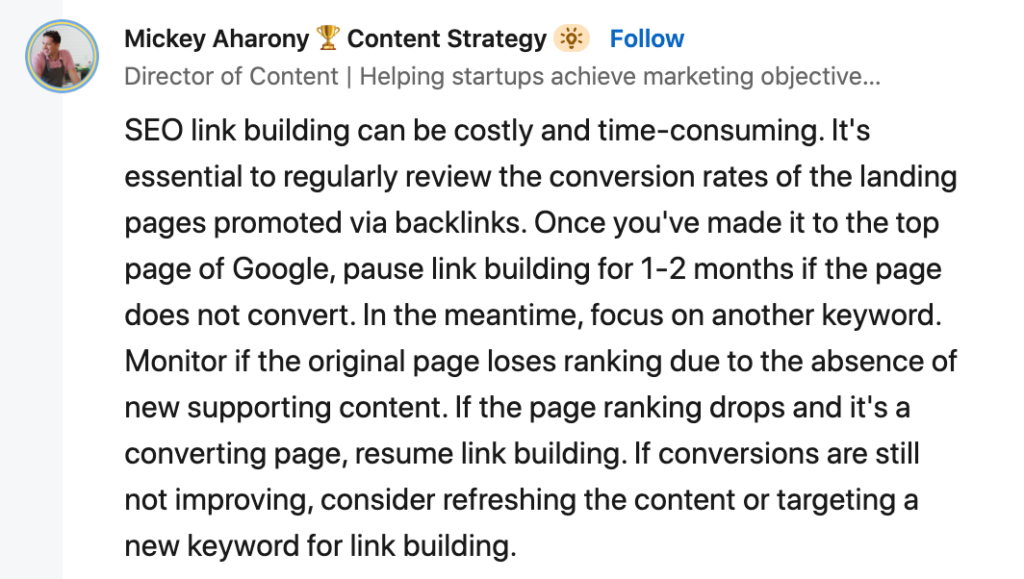
It’s not the strategies or even budget that define the success of your link-building plan. The most important component of your plan is its alignment with your goals.
Do you want to grow traffic? Do you want more leads? Do you want to increase your site’s authority? Oftentimes, there may be completely different pathways to each of these objectives.
Define your goals first and talk to us then. Our experts will help you build links that get you closer to your objectives.